How A Tennis Ball & Stretching Can Help Relieve Sciatic Nerve Pain


Did you know that you could…Get relief from your sciatica pain without the need of pharmaceutical drugs or surgery?
I know it sounds crazy because we’re accustomed to hearing about people taking medication, various home remedies, topical creams, or even resorting to surgery in a desperate search for sciatica pain relief all with varying levels of success.
However, I’m going to share three tips with you today that’s going to change the way you think about your sciatica pain and get you relief fast! You can also explore some effective stretches for sciatica pain relief from the comfort of your own home.
I’m Dr. Hafeez Merani and I am honoured to have been named one of the three best chiropractors in Burnaby, B.C. who has helped countless patients get their life back by relieving them of their excruciating sciatica pain, using my highly recommended and effective chiropractic treatments.
Based right here in Burnaby, BC, at our clinic conveniently located near the vibrant Metrotown area, we’re dedicated to bringing the best chiropractic solutions to our community.
So, what is Sciatica At-Home Pain Relief?
It’s an in-depth self-treatment, that you can do from the comfort of your own home.
It’s a simple way to diagnose what type of sciatica you might have, the cause of your pain and how to treat it with exercise and stretches.
So I’m going to share with you 3 tips about an in-depth self-treatment, that you can do from the comfort of your own home, and how you can get fast and effective relief from your sciatica pain, without the need of pharmaceutical drugs or surgery.
Our guide is especially useful for residents of Burnaby, offering techniques that can be easily integrated into your daily routine, whether you’re working from home or need a quick session after exploring the trails of Burnaby Mountain.
And I know what you’re probably thinking:
You’ve tried every type of treatment, stretches, exercises, pain pills and nothing ever helped with the unbearable pain you experience constantly from your sciatica.
But again, I’m going to show you a great way you can pinpoint your specific type of sciatica, how to treat it and get amazing results.
So the first tip is…
How To Know What Type of Sciatica You Have and How To Treat It
The big idea here is that not all sciatica is the same, and if you don’t know what type you have, you could be making your symptoms worse.
This is important because many people think that all exercises, stretches and treatments are the same for sciatica, but that couldn’t be further from the truth.
In fact, this is one of the biggest reasons why so many people suffer in pain for years with their sciatica, because they have no idea what mechanism is causing sciatica they have and how to properly treat it.
The second tip is…
Stop Using Hot and Cold Compresses The Wrong Way
The main thing to understand here is that when people are experiencing that sharp pain shooting down their leg, many times they reach for either an ice pack or a hot pack, not knowing that they could actually be making it worse.
This means if you continue grabbing the wrong hot or cold pack for your sciatica, you are likely going to make your pain even more unbearable, to the point where just sitting is painful, let alone walking.
As the pain gets worse, sleeping can become much more challenging therefore increasing your pain levels and ultimately exacerbating the condition.
The third tip is…
How To Know If Your Sciatica Is Getting Better or Worse
Learn how to tell if the pain that you are feeling, means you’re getting better or making things worse for yourself.
This is important because in the beginning of your recovery, you might just feel pain for a while, and not necessarily feel any so-called “relief”, especially if there has been inflammation for a long period of time.
So you need to know if the pain that you are feeling, is a good pain and you are on your way to recovery, or if it is a bad pain and you need to stop what it is you’re currently doing.
Now, I know what you’re thinking…
These tips are all sounding too good to be true and are probably helpful for other people’s sciatica, but yours is different, right?
Well, here’s the thing, I know you’ve probably tried everything already.
You’ve been to many chiropractors, physiotherapists and massage therapists.
You’ve done all the exercises and stretches before, and nothing ever seemed to take away that excruciating pain that you feel on a daily basis.
But that little voice that is saying, “What if this doesn’t work?”
Challenge it by saying, “What if it does?”
And so I’ve created this in-depth self treatment guide that you can do from the comfort of your own home.
You don’t have to come see us in our chiropractic clinic.
You can do this at your convenience, your own pace and comfort level.
You can even take this information to your trusted medical care provider and get their feedback on it before ever trying it.
It’s completely up to you
It is my hope that you’re better able to determine and treat your specific type of sciatica with the proper stretches and exercises, and also show you what not to do that could agitate your pain even more.
All of this from the comfort of your own home.
And I, as one of Burnaby’s best chiropractors who has helped countless patients get their life back by relieving them of their sciatica pain, what I do is help people realize and pinpoint the root causes of their pain, and I show them exactly what they can do to prevent it in the future.
Please consider using and sharing this in-depth self treatment guide in hopes that it will help you in relieving your sciatica pain.
And best of all…
It’s completely free.
We’re always here to help and I hope you’re able to join the other individuals who have received relief from their sciatic symptoms by using our guide, who were struggling with pain.
If you like this free guide, be sure to check out our free ebooks on topics like:
- What To Do After a Car Accident
- How Custom Orthotics Can Help You
- How To Find An Amazing Chiropractor
But today we’re talking about the in-depth self treatment for your sciatica pain.
I can’t wait for you to try it, enjoy!
What Is Sciatica And Its Relationship With Low Back Pain?

The prevalence of low back is very high in industrialized countries, with some articles claiming rates of between 60-70% that affect the population.
Low back pain can then be further classified into acute or chronic, keeping in mind that symptoms can flare up due repeated trauma to the injured site.
Sciatica, however, is a much more specific condition that is often linked with low back pain and is the subject of this blog post.
Sciatica is a medical diagnosis characterized by lower back pain and radiating pain down the leg that results from irritation of the sciatic nerve roots.
The sciatic nerve passes underneath the piriformis muscle, runs down the leg, and terminates behind the knee where it bifurcates into different branches that innervate the leg.
It provides direct and indirect motor function to muscles of the lower body, as well as sensation to parts of the lower leg and foot.
Where Is The Sciatic Nerve?
The photo below illustrates the close proximity the sciatic nerve has to the piriformis muscle.
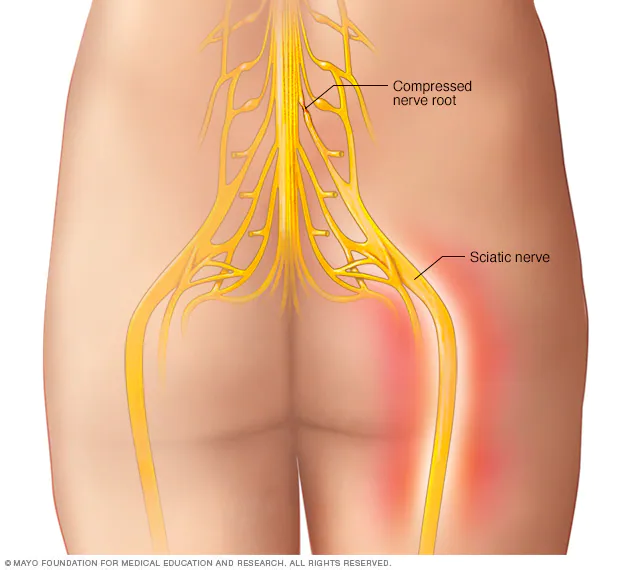

Image Source: Mayo Clinic
Due to this intimate relationship, when the piriformis muscle becomes spastic, it can pinch the nerve initiating a pain cascade and the beginnings of sciatica.
Be sure to continue reading to learn the different sciatic nerve pain stretches to help relieve your pain.
How Prevalent is Sciatica?
It has been estimated that up to 40% of individuals in a population experience sciatica symptoms at one point in their lifetime.
How Does Sciatic Pain Commonly Present?
Sciatica pain is most often unilateral (one-sided) and described as a painful, aching, prickling, and/or burning sensation.
Affected areas include, but are not limited to, the buttocks, lower back, below the knee, on the back of the calf, on the sole of the foot.
The pain can persist from four to eight weeks in the short-term (acute sciatica) or a longer period of time (chronic sciatica).
It can be aggravated by flexion of the lumbar spine, twisting, bending, and coughing. Other symptoms of sciatica are leg weakness or heaviness.
What Causes Sciatica?


Many people wonder how to stop sciatic nerve pain, but in order to know that, you must first understand what sciatica is.
Sciatica is commonly caused by conditions that irritate and/or compress the sciatic nerve.
Below is a list of some of the most common causes, but please keep in mind that this is meant to be an exhaustive list.
Spinal causes (majority of cases)
- Lumbar bulging or herniated disc
- Spinal stenosis
- Degenerative disc disease
- Spondylolisthesis
- Spinal tumors in the lumbar region (rare)
Non-spinal causes
- Piriformis syndrome
- Trauma
- Post-operative complications
What Type Of Sciatica Do I have?
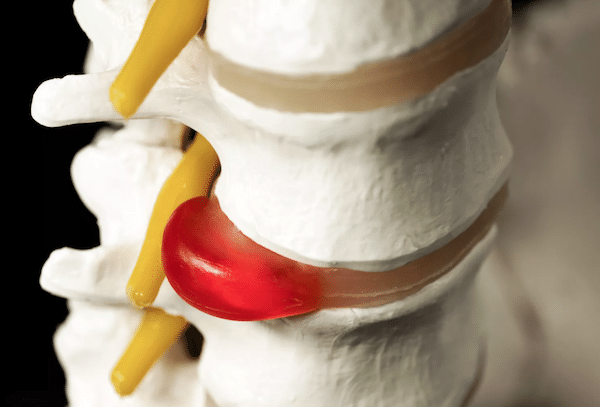

As you’ve now learned, sciatica can stem from many different areas and this will then inform the type of pain that you experience.
For sciatica that comes from the spine (ex. disc bulge or herniation), the pain will typically start in your lumbar spine where the pathology is and travel directly into either or both of your legs.
The limb the pain radiates into depends on which nerve root has become compromised.
For sciatica that starts after a nerve exits the spine (ex. piriformis syndrome), the pain will start in a limb and radiation will occur down one leg in most situations and not be in your spine.
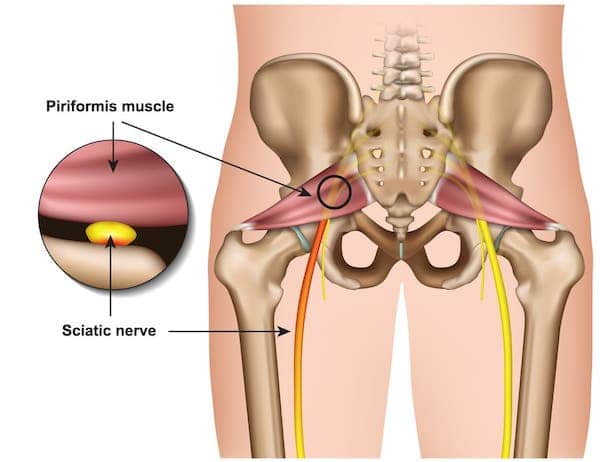

The above two options are key differences and act as a start to differentiate the tissues that are injured.
Sciatica Or Piriformis Syndrome? What Is The Difference?
While it can be difficult to differentiate sciatica from other conditions creating similar symptoms of pain in the low back and leg(s)
Distinct symptoms of sciatica are:
- Low back (lumbar spine) pain
- Pain felt only on one side of lower body (eg. one leg)
- Deep pain or burning feeling in the glutes of the associated side
- “Pins and needles”
- Heaviness or weakness in the leg and/or pain upon a straight leg raise
Such symptoms arise due to irritation of the sciatic nerve due to an injury or spasm, causing swelling or compression of the Piriformis muscle.
However, because of the variance in orientation of the sciatic nerve to the piriformis muscle, passing next to or through the piriformis muscle, one can experience sciatica like symptoms especially when the nerve passes through the muscle.
In the majority of individuals, it is common for the Sciatic nerve to pass through the Piriformis muscle, thus initiating pain in the low back and hip, ultimately causing poor movement and balance leading one to experience what is known as Piriformis Syndrome.
In fact, beginning symptoms of Piriformis Syndrome will be between the low back, hip and buttock regions that result in pain, tingling, or numbness especially in the buttock(s).
Such pain can be caused by previous trauma to the muscle or repetitive vigorous activities that recruit piriformis muscle use (eg. long distance running).
Furthermore, pain can also be elicited when stair climbing, applying pressure over the piriformis muscle, or long periods of sitting.
However, more severe chronic pain symptoms that run down the back of the leg(s) to the associated foot, can be cause for concern as it may be Sciatica.
Even still, the reason for one’s sciatica is not necessarily attributed to Piriformis Syndrome but can be considered as part of the differential diagnosis list.
You will also notice that you’ll be able to use many of the sciatica exercises for piriformis syndrome as well.
I Have Sciatica! Now What?


Don’t worry! As stated earlier, many individuals will suffer from back pain at one point throughout their life.
It’s likely that simple stretches for sciatic nerve pain, and conservative management like visiting your chiropractor, massage therapist, or physiotherapist will help to alleviate your pain.
The blog post endeavours to go through some simple techniques to help you in relieving sciatic pain.
What Exercises Can I Do For Sciatica?
In this article, you will learn many different exercises and stretches for sciatic back pain that you can do in the comfort of your own home.
You will also see how using a tennis ball for back pain could be very beneficial for you as well.
Simple Sciatic Nerve Stretches You Can Do At Home


Stretches to relieve sciatica nerve pain can easily be done at home.
Supine or Seated Piriformis Stretch
Supine Version
Lie on your back on a mat with your knees up and feet flat on the ground.
Cross the leg of the affected side so your ankle/shin rests on your other thigh.
Then gently, pull on the knee of the crossed leg towards your chest just enough that you feel the stretch deep in your glute muscle.
If you do not feel a stretch, grab the thigh of the affected side and pull it towards your chest.
Otherwise, hold the position for 5 deep breaths, and then switch to the other side and repeat.
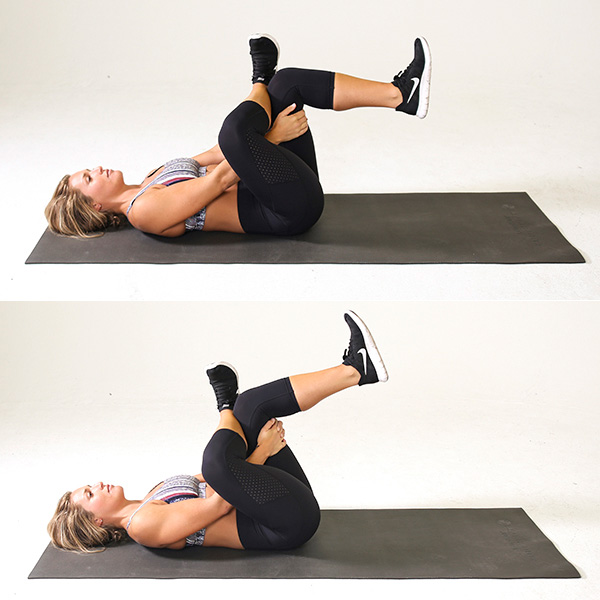

Image Source: openfit.com
Seated Version
Sit nice and tall on a firm chair to start, and then cross your right leg so that your right ankle rests on your left thigh.
At this point you should feel a deep stretch along the back of the right thigh into the buttocks.
This is an excellent exercise for sciatica pain in the buttocks.
If not, ensure you are still sitting up nice and tall as you exhale and hinge forwards at the hips and press down on the right knee.
Whatever your depth is in this stretch, hold the position for 5 deep breaths, and then switch to the other side and repeat.
Long Adductor (Groin) Stretch
Sit on the floor with your legs outstretched with a slight bend in the knees, and place your legs as far out as they go in opposite directions.
Then sit up nice and tall and rest your palms on the floor in front of you, and gently hinge at the hips, letting your palms slide forwards.
Only go as far forwards until you feel a light stretch, and hold for 5 deep breaths.
**Note: if you experience any pain in the thighs or behind the knees stop immediately
Short Adductor (Groin) Stretch
Sit on the floor with the soles of your feet touching and hold your ankles with each hand and inhale deeply and stay in this position for 5 deep breaths.
If you do not feel the stretch, gently push down on your knees with your elbows.
Stop if you feel any pain, and ease off pushing down on your knees a couple of inches before you stay there for 5 deep breaths.


Image Source: verywellfit.com
Knee Hug Stretch
The following sciatic nerve stretch is done by lying on your back on a mat, tuck your chin down slightly (use a thin book or a thinly folded towel for more comfort), and bend your knees so that your feet are flat and hip width apart.
Relaxing the upper body, using both hands hold your right thigh just below the knee joint and hug the knee towards your chest.
At this point you may already feel a stretch in the low back, hip, and buttocks on the right side.
If not, gently start to straight the right knee as you continue to hold the leg until you feel a slight stretch.
Then hold for 5 deep breaths, before lowering the leg and returning to the starting position, and then trying it on the left side.
For time efficiency, this can be tried by hugging both knees towards your chest.
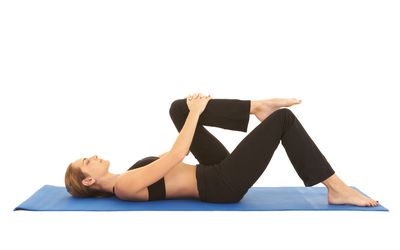

Image Source: verywellfit.com
Side-Lying Clamshell
Start by lying on your side with the affected side facing the ceiling. Keeping your feet stacked on top of another, bend your legs back so that your knees form a 90 degree angle.
As you keep your spine neutral, ensure your hips are also stacked on top of each other such that both hips make a straight line towards the ceiling.
Now lift the top knee up, being careful not to roll backwards with your hips and the body remains in the starting position.
Then bring your knee back so that you are back in the original position.
Repeat 10 times. Please note this exercise should only be done in a pain free manner.
Hip Extension
Floor Version:
With your hands and knees on the mat to start, make sure that your hips and knees make a straight line, as well as your wrists and elbows with your shoulders.
Next, make sure to keep a neutral spine, by tucking your chin down, and gently engaging your core.
Then turn your right toe up towards your shin, and gently lift the right leg up towards the ceiling, keeping your spine neutral. Repeat 10 times.
Please note these sciatic nerve exercises should only be done in a pain free manner.
Standing Version:
Stand with your feet shoulder width apart behind a sturdy chair or at a counter, place both hands on the back of the chair or counter.
Stand up nice and tall with your feet shoulder width apart, and a slight chin tuck for proper neck alignment.
Turn your right toes up towards your shin and gently lift your right leg back without arching your low back. Lift far back enough that you feel a slight stretch of the abdominal muscles.


Nerve Flossing Exercises For Sciatica & Piriformis Syndrome
What is Nerve Flossing?
Nerve flossing is a technique that can be done on your own to aid with proper nerve gliding in the body, such that it is also known as neural or nerve gliding.
By engaging in nerve flossing painful symptoms of sciatica, due to irritation or constriction of the sciatic nerve, may be relieved.
Furthermore, nerve flossing exercises can increase one’s flexibility and strength for overall general health, resulting in possible improvements in one’s range of motion and reduction of damage to the nerve(s) itself.
Nerve flossing is used by chiropractors and physiotherapists alike, and can have a significant impact in decreasing pain.
Nerve Flossing For SCIATICA: Seated Sciatic Nerve Floss
Sit nice and tall on a sturdy chair with a slight chin tuck to for proper neck alignment with both feet flat on the floor.
Then straighten the right knee in front of you with your foot/toes turned up, as far as they go, towards your shin; and lift your chin up and tilt your head back so that you are looking up at the ceiling.
Then bring your chin back down towards your chest at the same time that you lower your lower right leg back slightly more than 90 degrees.
Repeat this on the right side 10 times before switching to the left side for 10 repetitions.
Nerve Flossing For PIRIFORMIS SYNDROME: Lying Outer Hip Stretch
Start by lying flat on a mat with both legs straight.
Next, bend the right leg and use the left hand to hold the leg under the knee, as you bring the right knee across towards the left shoulder.
Hold this stretch for 5 deep breaths and switch sides.
Stabilize yourself by keeping the right hand on the floor.
You should feel this stretch in the right hip, low back and in the right glute.
How Can I Use A Tennis Ball To Relieve My Sciatic Pain?
Sciatic pain can be incredibly debilitating, making it hard to sit, stand, or even walk.
The good news is that there are a number of simple exercises that can help to relieve the pain.
One effective way to target the sciatic nerve is to use a tennis ball.
Many people don’t know that you can use a tennis ball for sciatica pain relief, and it’s actually quite helpful.
As a result, using a tennis ball as a way to trigger point and release tension in muscles surrounding the sciatic nerve can be an effective way to modulate pain.
Let’s Try Standing First …
Use a firm tennis ball to roll against the lumbar muscles, gluteal and piriformis muscle group for 30 seconds – 1 minute.
The pressure should not be that which causes pain or numbness down the leg, but rather gentle enough to feel relieving after the sciatica tennis ball exercise is ceased.
Repeat the sciatica tennis ball exercise for effective pain relief between 5-10 times per day, or as directed by your medical practitioner.
Let’s Use The Tennis Ball On Your Low Back …
As we mentioned earlier, the lumbar spine musculature can also be affected with sciatica.
Using a tennis ball against the wall, use the ball to massage the lumbar paraspinal muscles on each side of the spine, being careful not to apply pressure to the vertebrae themselves.
Discover some simple exercises for sciatica pain that incorporate tennis balls to alleviate discomfort.
Pressure can be applied for 30 seconds – 1 minute in one area, and moved to different parts as needed
Ready For Something Harder With A Tennis Ball?
The picture above shows where you want to target the tennis ball – hold it in place for between 15-30 seconds, ensuring to move it periodically with the same caveat as above not to trigger any numbness down the leg.
What Else Can I Do To Help Relieve My Sciatic Pain?
In addition to the tennis ball release method and the various exercises for sciatica nerve pain explained above, other measures one can take to alleviate or prevent aggravating pain include:
- Use of cold/hot packs
- Practicing good posture
- Avoidance of wearing high heels
- Avoidance of prolonged sitting/standing
How Can I Use A Hot Or Cold Compress To Help Relieve My Sciatic Pain?


If your sciatic pain is in the acute phase (local inflammation and swelling), an ice pack is recommended to use initially for 10 minute intervals to help manage pain levels.
To prevent frostbite to the skin, place a towel or another barrier between the bag of ice and your skin while continually monitoring for changes in the colour of your skin or the loss of feeling in the area that you’re addressing.
If your sciatic pain has been present for a week or longer, and you notice a lot of muscle spasm around the affected area, consider using a warm compress or heat pack in between the cold pack.
The heat pack will reduce muscle spasm, in addition to hopefully decreasing some of the nerve pain.
Similar to the cold compress, heat should only be applied in 10 minute intervals, taking a 10 minute break in between.
How Do I Know If My Sciatic Pain Is Improving?
In most instances, as you begin to stretch the affected area and it begins to heal, the pain should centralize and return towards the area of complaint.
This is known as centralization of radicular pain.
In other words, if you were having low back pain with referral into your left leg and toes, as the area heals, the referral in your leg would start to recede so that it gradually is more in your heel, then knee, glute, and eventually only your low back.
If you have any further questions regarding this concept, feel free to consult your health care practitioner.
Stretching To Relieve Sciatica Pain Is Not Working – What Should I Do Now?
Since the above stretches to help sciatica are meant to be a general overview, it’s likely that you may need additional guidance from a trained medical professional.
If you find that stretching alone doesn’t provide the relief you seek, consider seeking guidance from a trusted chiropractor. Learn more about what chiropractors do, who can benefit from their services, and how frequently you should visit them.
Dr. William Liang, a seasoned dentist, wants to emphasize the importance of maintaining oral health, even when dealing with conditions like sciatica. The connection between oral health and overall well-being is often overlooked. Patients suffering from sciatica should remember that their dental health plays a significant role in their overall health. Neglecting regular dental check-ups and proper oral hygiene can lead to systemic inflammation, which may exacerbate conditions like sciatica. So, while seeking relief from sciatica pain, don’t forget to prioritize your dental health as well.
Are you tired of living with the constant discomfort of sciatica pain? It’s time to take control of your well-being and find relief. At Metrotown Family Chiropractic, our team of dedicated Burnaby chiropractors, including Dr. Hafeez Merani, one of Burnaby’s best chiropractors, is here to help. We specialize in effective chiropractic treatments that can make a real difference in your life. Whether you’re dealing with acute or chronic sciatica pain, our in-depth self-treatment guide, along with personalized care, can lead you towards a pain-free future. Don’t let sciatica hold you back any longer. Contact us today to schedule your consultation and take the first step towards a life without sciatica pain. Explore our website to learn more about our services and the wonderful city of Burnaby, BC.
References
- https://www.ncbi.nlm.nih.gov/books/NBK507908/
- https://citeseerx.ist.psu.edu/viewdoc/download?doi=10.1.1.900.3344&rep=rep1&type=pdf
- https://www.ncbi.nlm.nih.gov/books/NBK482431


